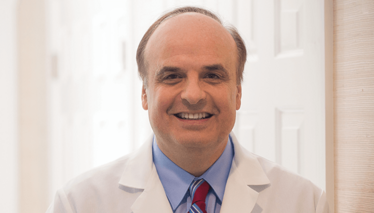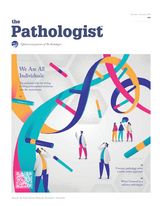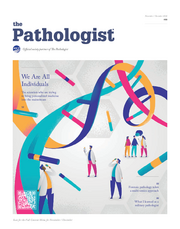Rising Pathology Rock Stars
Sitting Down With... Mark Boguski, Senior Vice President for Precision Medicine, Inspirata

What kick-started your career in pathology, genomics, and bioinformatics?
During my molecular biology PhD, pathology was at a historical turning point – new vistas into understanding diseases at the molecular level were being opened with new tools and technologies, and I wanted to be part of that.
As I was completing my pathology residency in the late ’80s/early ’90s, the dawn of the human genome project became the great scientific endeavor, and I was immediately drawn to the possibility that we could gain unparalleled insight into the cause of disease by decoding the whole human genome. I soon realized that if the project was going to fulfill its potential, it was going to mean analyzing lots of data with computers. Back then, computers in biology were only used by X-ray crystallographers, as most biologists didn’t see the need for them. I considered the future and recognized that biomedical research was going to become a data science – and that’s when I made the transition from pathology and molecular biology to bioinformatics and genomics.
You have published books on celebrity diseases – why?
About 10 years ago, my wife (who is also a physician) and I became frustrated when seeing reports in the media that conveyed superficial or incorrect information about the diseases suffered by public figures. We saw a real opportunity to address the health literacy gap by using professional athletes, Hollywood celebrities, and famous politicians as examples in our layman’s explanations of disease states. Many public figures are very open about disclosing their health struggles, so we’re not violating any medical confidentiality rules or regulations; we’re simply taking the conditions they’re disclosing and creating “teachable moments” so the average person can understand it in depth.
There’s a saying: “Pathologists are the most important doctors that most patients have never met.” I believe we should rectify that and spend more time with them. I see many of my colleagues taking the initiative by offering office hours so that patients can gain a better understanding of what’s happening; they’re almost always grateful for the experience because it enlightens and empowers them.
You’ve been credited with coining the term “precision medicine” – how do you define it?
To me, precision medicine has three essential attributes: understanding the root mechanistic cause of disease; having the ability to detect those causal factors with a test – biomarker analysis, clinical laboratory tests, and so on; and possessing treatment that can target the root causes.
Personalized medicine, on the other hand, can be done with or without precision medicine and takes into account many other factors, such as patient comorbidities, family history, and their compliance with treatment – drugs don’t work if people don’t take them correctly (or at all!)
When the term “personalized medicine” became commonly used around a decade ago, many physicians took offense because they felt they had always provided treatment that was individualized to patients. I think it’s a good thing that we’re now more focused on precision medicine; it’s something that we can define by those three attributes, and still incorporate into a personalized approach.
What outstanding moments in your career would you like to relive?
There are two. I was very fortunate to start my professional life when the human genome project began – being part of it was a once-in-a-lifetime opportunity. In terms of a singular moment, I’d say publishing the first comprehensive map of the human genome in 1996 in Science. To me, it was one of the first – if not the first – examples of big data analytics in biomedicine.
I also take a great deal of pride in the invention of comparative genomics (http://tp.txp.to/markboguski) – using the unity of biology across many different levels to study other organisms, such as yeast and fruit flies, and gain insight into the pathophysiology of human disease. In fact, in 1990 we discovered the cause of neurofibromatosis by comparing the human gene to related genes in yeast! This comparative genomics approach accelerated drug discovery tremendously.
What’s next?
I’m already right in the thick of my next move! As the head of precision medicine at Inspirata, I’m helping to develop the databases and software tools that will push pathology forward. We’re also launching new platforms for knowledge visualization, just-in-time learning and clinical decision support.
A couple of years ago, Forbes magazine predicted that pathologists will be the real big data rock stars of healthcare, and they made that assertion because it’s believed that up to 70 percent of clinical decisions are based on laboratory data. Recently, a friend of mine (the Chairman of Pathology at a major Harvard-affiliated hospital) told me that the switch over to a new electronic health record system allowed them to see that 500 million pathology reports (compared with only 14 million radiology reports) were generated in their hospitals over a five-year period. By any definition that’s big data – and we’re certainly not maximizing its utility in precision medicine.
With that in mind, I’m working towards making Forbes’ prediction a reality. I want to empower pathologists to be the big data rock stars of precision medicine – and to use powerful new technologies to improve outcomes and reduce costs for patients and society.

After graduating with a pharmacology degree, I began my career in scientific publishing and communications. Now with more than 16 years of experience in this field, my career has seen me heading up editorial and writing teams at Datamonitor, Advanstar and KnowledgePoint360 group. My past experiences have taught me something very important – that you have to enjoy working with, and have respect for your colleagues. It’s this that drew me to Texere where I now work with old colleagues and new. Though we are a hugely diverse team, we share several things in common – a real desire to work hard to succeed, to be the best at what we do, never to settle for second best, and to have fun while we do it. I am now honored to serve as Editor of The Pathologist and Editorial Director of Texere Publishing.




















